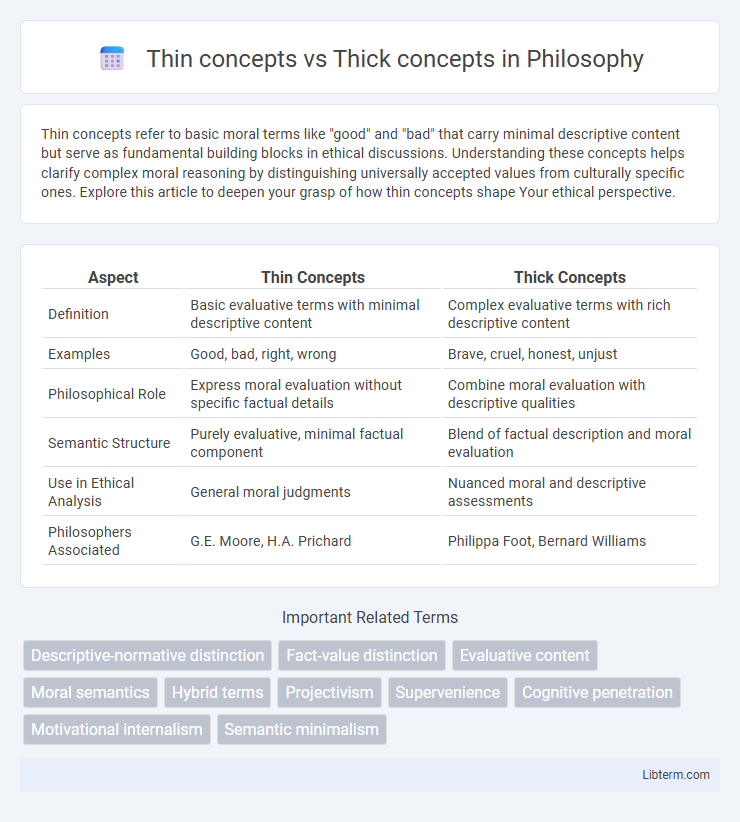Thin concepts refer to basic moral terms like "good" and "bad" that carry minimal descriptive content but serve as fundamental building blocks in ethical discussions. Understanding these concepts helps clarify complex moral reasoning by distinguishing universally accepted values from culturally specific ones. Explore this article to deepen your grasp of how thin concepts shape Your ethical perspective.
Table of Comparison
| Aspect | Thin Concepts | Thick Concepts |
|---|---|---|
| Definition | Basic evaluative terms with minimal descriptive content | Complex evaluative terms with rich descriptive content |
| Examples | Good, bad, right, wrong | Brave, cruel, honest, unjust |
| Philosophical Role | Express moral evaluation without specific factual details | Combine moral evaluation with descriptive qualities |
| Semantic Structure | Purely evaluative, minimal factual component | Blend of factual description and moral evaluation |
| Use in Ethical Analysis | General moral judgments | Nuanced moral and descriptive assessments |
| Philosophers Associated | G.E. Moore, H.A. Prichard | Philippa Foot, Bernard Williams |
Introduction to Thin and Thick Concepts
Thin concepts, such as "good" or "bad," carry minimal descriptive content and primarily express approval or disapproval. Thick concepts, like "courageous" or "cruel," combine evaluative judgment with rich descriptive detail about specific behaviors or qualities. Understanding the distinction between thin and thick concepts is essential in ethics and philosophy for analyzing moral language and reasoning.
Defining Thin Concepts
Thin concepts are moral terms characterized by a narrow scope and minimal descriptive content, such as "good," "bad," "right," and "wrong." They primarily express evaluative judgment without providing detailed information about the context or reasons behind the assessment. Defining thin concepts involves emphasizing their function as tools for basic moral evaluation rather than conveying rich or specific moral content.
Defining Thick Concepts
Thick concepts are evaluative and descriptive, carrying both factual content and moral or normative significance, such as "courage" or "cruelty." They differ from thin concepts, which are primarily evaluative and abstract, like "good" or "bad." Defining thick concepts involves understanding their dual role in conveying rich descriptive detail alongside ethical judgment, making them essential in moral philosophy and linguistic analysis.
Key Differences Between Thin and Thick Concepts
Thin concepts are abstract, context-independent moral terms such as "good" or "bad," characterized by minimal descriptive content and broad applicability. Thick concepts combine evaluative and descriptive aspects, offering detailed information about actions or traits, like "cruel" or "courageous," which entail moral judgment intertwined with factual content. The key difference lies in thin concepts' purely evaluative nature versus thick concepts' rich descriptive quality that connects moral evaluation with specific circumstances.
Historical Background of Thin and Thick Concepts
Thin and thick concepts originated in 20th-century analytic philosophy, with roots tracing back to moral philosophy and linguistic theory. Thin concepts, such as "good" or "bad," provide evaluative judgments with minimal descriptive content, while thick concepts like "courage" or "cruelty" combine evaluative and descriptive features, intertwining moral assessment with specific behavioral characteristics. Historical analysis reveals debates by philosophers such as Bernard Williams and Elizabeth Anscombe, who emphasized the complexity of thick concepts in ethical discourse, contrasting the reductionist tendencies found in earlier analytic traditions.
Philosophical Significance of Thin Concepts
Thin concepts, such as "good" and "bad," hold significant philosophical importance due to their minimal descriptive content and broad applicability across various contexts. They enable philosophers to analyze fundamental moral judgments without embedding substantial factual assumptions, facilitating clearer debates on ethical theory and normative principles. The abstraction inherent in thin concepts allows for cross-cultural comparisons and foundational explorations of value that are essential in metaethics.
Moral and Ethical Dimensions of Thick Concepts
Thick concepts embody both descriptive and evaluative elements, intricately linking moral or ethical significance with factual content, unlike thin concepts which are primarily evaluative and abstract. These concepts, such as "cruelty" or "courage," provide rich context that shapes moral judgments by integrating empirical details with ethical meaning. The dual nature of thick concepts allows for nuanced understanding of human behavior and ethical deliberation, enhancing moral discourse beyond mere shorthand evaluations.
Role of Context in Understanding Thick Concepts
Thick concepts require contextual information to be fully understood because their meanings encompass both descriptive and evaluative elements. These concepts, such as "courage" or "cruelty," depend heavily on cultural, historical, and situational contexts to determine their significance and application. In contrast, thin concepts like "good" or "bad" provide basic evaluative judgments with minimal dependence on context, making thick concepts inherently complex and context-sensitive.
Debates and Criticisms Surrounding Thin and Thick Concepts
Debates surrounding thin and thick concepts often center on their role in moral philosophy and ethical discourse, with critics questioning the clarity and applicability of thin concepts due to their abstract and minimal descriptive content. Thick concepts, which combine evaluative and descriptive elements, face scrutiny for potential cultural bias and the difficulty in achieving universal agreement on their meanings and moral significance. Scholars also debate whether thin concepts provide sufficient normative guidance or if thick concepts complicate ethical analysis by intertwining facts and values.
Implications for Contemporary Moral Philosophy
Thin concepts such as "good" and "bad" express simple evaluative judgments with minimal descriptive content, while thick concepts like "courage" and "cruelty" combine evaluative and descriptive elements, enriching moral discourse. The integration of thick concepts challenges contemporary moral philosophy to bridge the gap between factual understanding and normative evaluation, emphasizing context-dependent moral reasoning. This complexity prompts renewed debates on objectivity, cultural relativism, and the capacity of moral language to convey nuanced ethical insights.
Thin concepts Infographic

 libterm.com
libterm.com